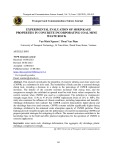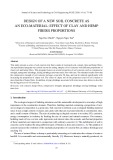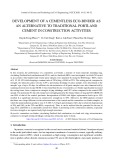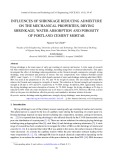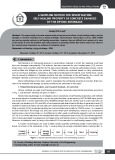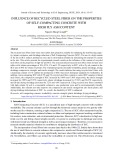
Drying shrinkage
-
This research investigates the properties of concrete utilizing coal mine waste rock (CMWR) as a substitute for river sand. The workability of fresh concrete is assessed through slump tests, revealing a decrease in a slump as the percentage of CMWR replacement increases.
 13p
13p  vibecca
vibecca
 01-10-2024
01-10-2024
 0
0
 0
0
 Download
Download
-
This study presents a series of soil concrete mix that is made of excavated soils, cement, lime and hemp fibers. An experimental program was carried out on the testing samples of soil concrete with different proportions of clayey soil and hemp fibers.
 12p
12p  vifilm
vifilm
 24-09-2024
24-09-2024
 1
1
 1
1
 Download
Download
-
In this research, the performance of a cementless eco-binder, a mixture of waste materials including slag, circulating fluidized bed combustion ash (CFA), and rice husk ash (RHA) was investigated, in which CFA acted as an activator.
 13p
13p  vifilm
vifilm
 24-09-2024
24-09-2024
 2
2
 1
1
 Download
Download
-
Drying shrinkage is the main cause of early age cracking of concrete and mortar. A wide range of research has been conducted to reduce the drying shrinkage, including using fibres or chemical admixtures. This paper investigated the effect of shrinkage reducing admixture on the flexural strength, compressive strength, drying shrinkage, water absorption and porosity of mortar.
 13p
13p  vifilm
vifilm
 24-09-2024
24-09-2024
 2
2
 1
1
 Download
Download
-
This paper briefly overviews experimental procedure and methods of self-healing studies; and the damage of concrete materials due to drying shrinkage. Microstructure observations such as SEM, ESEM are used as popular methods in self-healing researches; however, they are difficult to be carried out in case of 3D-cracks.
 7p
7p  viyoko
viyoko
 24-09-2024
24-09-2024
 5
5
 1
1
 Download
Download
-
The recycled steel fibers from waste steel cables have properties suitable for enhancing the load-bearing capacity, impact resistance, and shrinkage reduction of Self-Compacting Concrete (SCC). The use of a high content of fly ash in SCC reduces production costs and is environment friendly by minimizing the amount of cement in the mix. This article presents the experimental research results on the influence of the content of recycled steel fibers on the properties of high-fly-ash SCC.
 13p
13p  vifaye
vifaye
 20-09-2024
20-09-2024
 2
2
 2
2
 Download
Download








